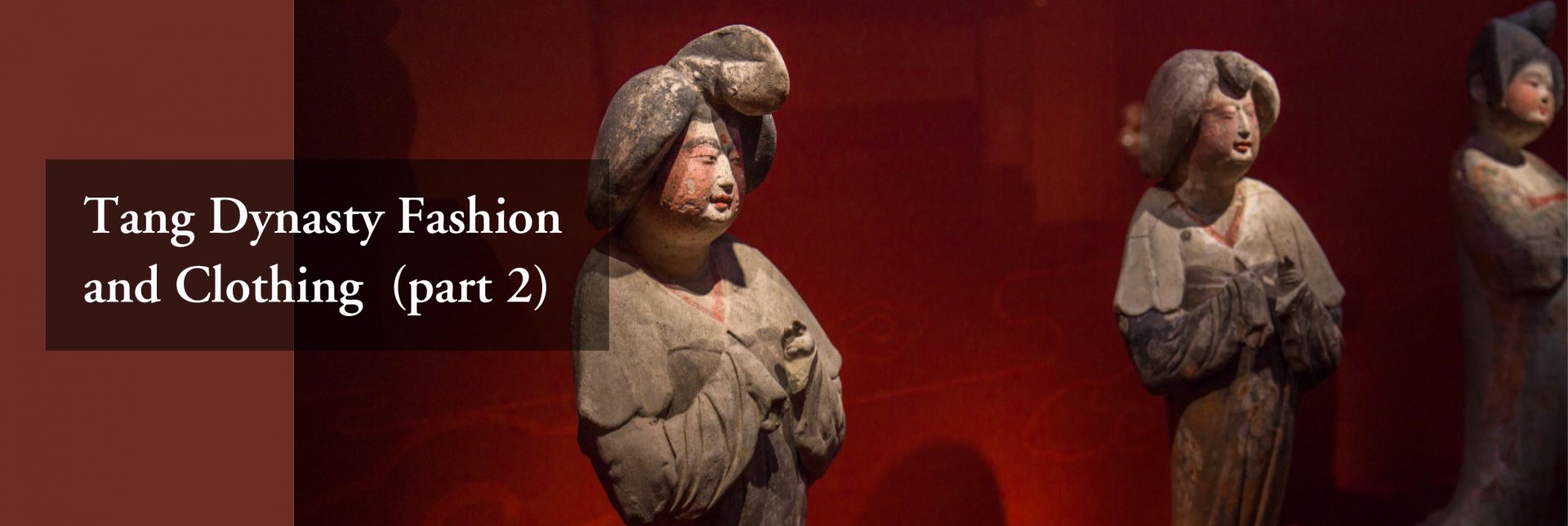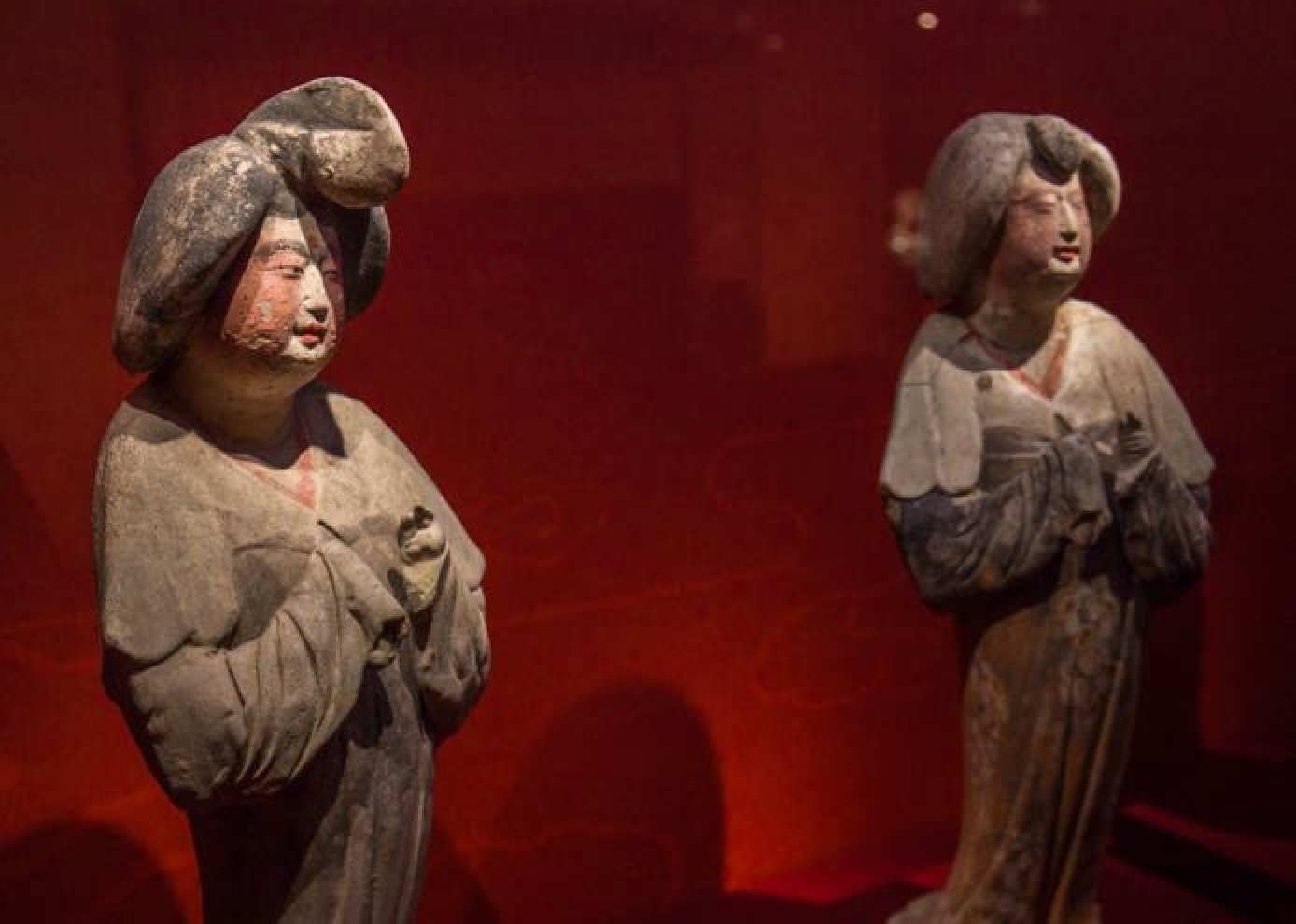The composition of the main costumes of the Tang Dynasty
Mr. Shen Congwen’s (沈從文)book "Flowers, Flowers, Altars, Pots, and Pots(花花朵朵罈罈罐罐)" mentions that in the murals unearthed from the middle and modern times, we can recognize the differences in women clothing amongst the early Tang, the prosperous Tang, and the late Tang without much effort. We can see this from the dress collocation, silhouette, fabric, and colors. Let us study the upper body first. The upper garments include undergarments, shirts, jackets, half-arms, and drapes.
Generally speaking, Ru (襦) could be single-layered and made of general-thickness material, but it could also have a thin lining. Most Ru was short and stopped at the waistline or higher position. They were often inserted into the skirt, and there was a type of waistband for modification, which made the waist or bust line more suppressive and prominent. The neckline of Ru often changed, such as round, peach-shaped, square, and heart-shaped. In the early Tang Dynasty, the cuffs of Ru were narrow in different lengths.
The shirt was also mostly single-layered, similar to Ru, but it could reach thigh length or even longer. The sleeves were of different lengths or sleeveless. They were often worn outside skirts, and their function was to absorb sweat. They were ordinary clothes in summer. Ru, shirts, and other jackets of Tang women were the daily casual clothes of all classes. Yuan Zhen's(元稹) poem "Lotus root silk shirt and willow flower skirt" Li He's (李賀)poem "wears a lotus silk skirt with pink and red ribbon", and Ouyang Jiong's (歐陽炯)poem "the red-sleeved girls are attracted to each other”. All indicate that Ru and shirts were common for women in the Tang Dynasty. They liked colors such as dark red, multicolor combo, and peacock green. For "Silk shirts are heavily embroidered with leaves and leaves, and a cluster of golden phoenix and silver goose”. Embroidery was of decoration, and the appearance was so beautiful that words failed to express it. Some were made of Chiffon. It was as light as rising smoke and as thin as a cicada wing. It was “Fine yarned silk fabric is of see through.” In addition to being aesthetically pleasing, it also has a cooling function.
Outer Jackets (襖)were dresses with lining or quilting, which could be thick or thin according to the needs of the four seasons. People wore them in autumn and winter. Of course, it was suitable for spring when the warmth turned cold. Most jackets were double-breasted and half-arm styles with knot buttons on the chest for fastening. If the jacket was longer than the knees, it was called a long jacket, which was warmer.


The half-arm's (半臂) sleeves were slightly shorter than the shirt ones. Its bodice was tight but with wide sleeves. The cuffs could had fringes or gatherings for decoration to increase the aesthetic feeling. Functionally, the sleeve cutting could also reduce the burden caused by the multi-layered sleeves. Therefore, the wearer could move more freely.
The long wrapping scarf ( 披帛) was an indispensable part of clothing in the Tang Dynasty.
[Interpret Name · Interpret Clothes (釋名·釋衣服)] said: “Shawl is also a long scarf, draped over the shoulders and wrapped around the back of the hands (帔,披也,披之肩背不及下也)”.The Book of Songs [Out of its east gate] (詩經: 出其東門) said: "Outside the Eastern Gate, there are many pretty girls, like downy clouds. Although there are many, not one is my sweetheart. My sweetheart is in a white dress with a green scarf. She is the one I miss." There was also a mention of a scarf (披), a sign of a virtuous woman in that period. In the era of the Book of Songs, wrapping scarves had already appeared.
Due to the fashion, the scarf width and length also changed accordingly. In Wen Tingyun's (溫庭筠)[Nvguanzi(女冠子): " With a pink scarf being like a sunset glow, hair being like clouds, and a mirror inlaid with gold, her face is as pure as snow" and Li Bai (李白)" Holding the bright and clean hibiscus in her plain hand, she wears shiny clothes dragging the long scarf, floating to the sky".These poems pointed out that Tang women imposed scarf around their shoulders, wrapped around the arms tucked into the chest front. What elegant curvaceous beauty was when walking!
The Long Wrapping Scarf and the Half-arm, not only help to increase the layering of the clothing but also help to cover the body. While the front bodice cutting tended to be "Show-off" during the Wu Zhou(武周) period, Long Wrapping Scarf became more necessarily effective.

For the bottom, skirts were the main one. There were rich in styles and colors, such as floral skirts, gold silk skirts, striped skirts, and golden strands skirts. In terms of fabrics, there were silk brocade, linen, and cotton skirts. Skirts were popular among young women in the early Tang Dynasty. In addition, the pomegranate skirt was dyed bright red from a liquid agent refined from the pomegranate flower, which was the most popular and colorful. In the Tang poems, there were "Under the cloud, a pretty lady with pink rouge and crescent eyebrows, wearing a pomegranate skirt, riding a white plum blossom horse. ( 紅粉青蛾映楚雲,桃花馬上石榴裙)" and "The eyebrows win the day lily color which makes it felt ashamed, and the red skirt is jealous of the pomegranate flowers. ( 眉黛奪得萱草色,紅裙妒殺石榴花)"How can you imagine people dyeing pomegranate red cloth everywhere when the pomegranate flowers were blooming?
Pleats are a kind of "gatherings (襇)".A gathering Pleated skirt was usually made with several cutting pieces of cloth. In addition, there were sheep pleated skirts, commonly called sheep intestine skirts, because they shrunk into the shape of sheep intestines. This type of skirt consumed a lot of fabric. The procedures of the making-up method were rather complicated, so it usually appeared as a short skirt, which was super-imposed on top of a long skirt. This way of wearing added a sense of layering, and beauty and kept warm. Among the skirts in the Tang Dynasty, there were also skirts made of woolen yarn or colorful brocade, such as flower cage skirts, gold hazel skirts, and aviary feather skirts. For example, the gold-haired skirt was made of soft silk fabric, which hand-stitched the fancy patterns with thick gold threads or inlaid with gold edges. It is a patchwork process nowadays.
The most amazing thing is the bird feather skirt. Princess Anle (安樂公主) was born to Tang Zhongzong (唐中宗)and Empress Wei(韋后). She had an indulgent personality and lived a luxurious life. The strange thing about this “Hundred Bird Skirt” that she wore was that it changed color. This skirt was one color when viewed from the front and another color when viewed from the side. It was one color under the sunlight and another color in the shadow. The color of the clothes would change with different viewing angles. People could distinguish the shape of each bird on the skirt. Princess Anle’s feather skirt was in fashion. Therefore, the merchants, celebrities, royal officials, and even ordinary ladies, all followed suit. They searched mountains and valleys and swept away all the strange birds.
All articles/videos are prohibited from reproducing without the permission of the copyright holder.




Welcome to leave a message:
Please Sign In/Sign Up as a member and leave a message古代服裝/服飾原來都非常講究
#1
mo Mo
09-04-2023 21:37:12
好!
#2
Sek Biu Wai
24-03-2023 18:33:08